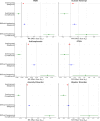This is a preprint.
Sleep inertia drives the association of evening chronotype with psychiatric disorders: epidemiological and genetic evidence
- PMID: 39314956
- PMCID: PMC11419237
- DOI: 10.1101/2024.09.10.24313197
Sleep inertia drives the association of evening chronotype with psychiatric disorders: epidemiological and genetic evidence
Abstract
Evening chronotypes (a.k.a. "night-owls") are held to be at greater risk for psychiatric disorders. This is postulated to be due to delayed circadian timing increasing the likelihood of circadian misalignment in an early-oriented society. Circadian misalignment is known to heighten sleep inertia, the difficulty transitioning from sleep to wake characterized by low arousal and cognitive impairment, and evening chronotypes experience greater sleep inertia. Therefore, difficulty awakening may explain the relationship between evening chronotype and psychiatric disorders by acting as a biomarker of circadian misalignment. In analyzing the longitudinal incidence of psychiatric disorders in the UK Biobank (n = 496,820), we found that evening chronotype predicted increased incidence of major depressive disorder, schizophrenia, generalized anxiety disorder and bipolar disorder. Crucially, this effect was dependent on sleep inertia, which was a much stronger predictor of these disorders, such that evening types without sleep inertia were at no higher risk as compared to morning types. Longitudinal analyses of suicide and depressed mood (CES-D score) in the Older Finnish Twin Cohort (n = 23,854) replicated this pattern of results. Twin and genome-wide association analyses of difficulty awakening identified the trait to be heritable (Twin H 2 = 0.40; SNP h 2 = 0.08), enriched for circadian rhythms genes and have substantial shared genetic architecture with chronotype. Marginal and conditional Mendelian randomization analyses mirrored the epidemiological results, such that the causal effect of evening chronotype on psychiatric disorders was driven by shared genetic architecture with difficulty awakening. In contrast, difficult awakening was strongly causally associated with psychiatric disorders independently of chronotype. Psychiatric disorders were only weakly reverse causally linked to difficult awakening. Collectively, these results challenge the notion that evening chronotype is a risk factor for psychiatric disorders per se, suggesting instead that evening types are at greater risk for psychiatric disorders due to circadian misalignment, for which sleep inertia may be acting as a biomarker.
Figures




References
-
- Au J. and Reece J., The relationship between chronotype and depressive symptoms: A meta-analysis. Journal of Affective Disorders, 2017. 218: p. 93–104. - PubMed
-
- Linke M. and Jankowski K.S., Chronotype in individuals with schizophrenia: A meta-analysis. Schizophrenia Research, 2021. 235: p. 74–79. - PubMed
Publication types
Grants and funding
LinkOut - more resources
Full Text Sources
